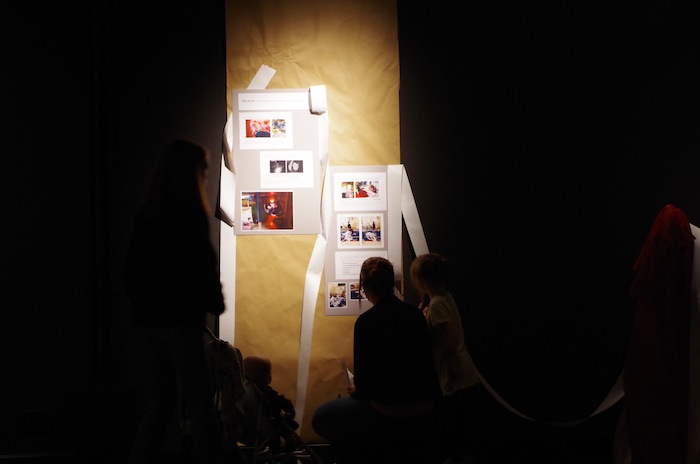In the past three years as Visiting Education Scholar at the Columbus Museum of Art, I’ve noticed something astounding happening in the museum’s education department. It’s transformative… and it is going viral, spreading to the children, teens, and adults who come to the museum to experience art as well as affecting those in the schools where museum educators do much of their good work.
And it all starts in the MUD…which stands for Making Use of Documentation. I asked Caitlin Lynch, a performance artist who is also a museum educator at CMA, what documentation has meant to her practice and teaching. Caitlin replied, “It’s everything! As an artist who works primarily in installation and performance, and who tries to foster collaborative experiences between strangers, documentation is often times the only way I have to reflect back on my work. Often times I am so in a performance, that I miss small, meaningful moments, especially between visitors. Reflection lets me see how my audience is responding to my provocations, almost always shaping what comes next, or where I take an idea. This is true as an educator as well. I can’t follow a student’s idea if I can’t remember it, and, much like a performance piece, being in the moment of teaching, it is often hard to catch and remember the true gems. It’s one thing to have me, another adult, tell you “Hey! This preschooler had a cool idea.” It’s quite another for me to show you an image of this same child making a giant, spontaneous, room-sized spiderweb, to trap all the adult ‘flies’…”
And just last week, Rachel Trinkley, the Assistant Director of Education for Schools, Teachers and Docents at CMA shared with me that “documentation has transformed the way I think about learning.”
Now when most people think of documentation, words like “transformation” do not usually come to mind. In fact, when I ask people to tell me what words they think of when they hear the word “documentation” they sometimes say things like “endless paperwork,” “dreary reports,” and even “covering your tracks.” But at the museum, rather than spending our time defining documentation, we’ve been practicing it and using it in a manner that is inspired by the way that the educators from the Italian pre-schools of Reggio Emilia use it (the Reggio schools were named in a Newsweek cover story as “One of the Best 10 Schools in the World”).
Rather than dreary paper work to cover your tracks, museum educators are using the Reggio educator’s practice of using documentation as a way to observe, record, interpret and share back moments of learning and thinking through a variety of ways including written quotes, photographic images, children’s artifacts as well as audio and video recordings in order to extend and deepen learning. Documentation is being used by museum educators with children, teens, and adults not only during the process of experiencing art and art making, but also after the experience is over. We’ve even begun to use it with funders as a unique way to show results and make visible the richness of learning about and through artful experiences.
But as I said earlier, much of this starts in the “MUD” i.e the monthly Making Use of Documentation meetings that museum educators are conducting. During these two hour meetings, these educators use protocols and rigorous ways of looking deeply at documentation from their programs in order to examine, ponder, and interpret powerful moments of learning. It is also during these MUD meetings that they learn with and from one another to continuously improve what they do with museum visitor experiences inside and outside the museum. When examining documentation (children’s words, artifacts, photographs, and teacher reflections) at a recent MUD meeting, two museum educators shared how their thinking and teaching was being transformed (there’s that word again!) as they were changing their teaching from “a reliance on materials to a reliance on listening and following the direction of children in order to spark their play and imagination.” Sparking children’s play, creativity, and imagination…now that’s something worth getting dirty for!
–Guest blog post by Fred Burton CMA Visiting Education Scholar

